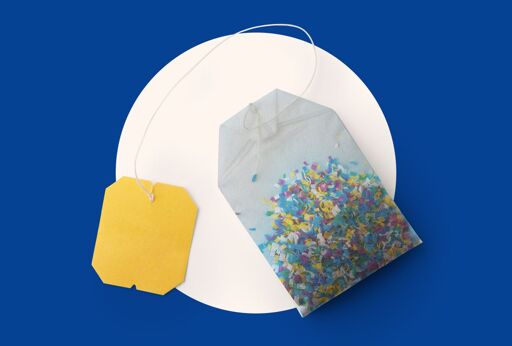Summary
A new study from Spain’s Autonomous University of Barcelona reveals that tea bags made from nylon, polypropylene, and cellulose release billions of micro- and nanoplastic particles when steeped in boiling water.
These particles, which can enter human intestinal cells, may pose health risks, potentially affecting the digestive, respiratory, endocrine, and immune systems.
Researchers urge regulatory action to mitigate plastic contamination in food packaging.
Consumers are advised to use loose-leaf tea with stainless steel infusers or biodegradable tea bags to minimize exposure.



.
I mean nothing about the methodology is even close to representing normal tea brewing behavior.
For starters, a typical cup of tea is around 300-350ml, not 2ml and certainly not 1, so the low end is already down to 23,371 particles even before accounting for the brewing technique.
Secondly, nobody holds their tea at an active boil while stirring it at 750 rpm. That’s virtually blending it. There isn’t a meaningful way to compare that to typical tea brewing behavior but I wouldn’t be surprised to learn that it produced 10,000x more particles.
.
I think you might have skimmed over the methods, but think what the OP was trying to say is:
Concentration: 300 tea bags / 600mL = 1 teabag per 2mL (175 tea bags in one 350mL cup of tea, doesnt appear typical?)
Mixing: 750rpm × [1m/60s] = 12.5 rotations a sec (Awfully fast to be stirring tea, constantly)
Incubation time: Not specified. (They could have left boiling overnight?)
There seems to be many points about the methodology that raise eyebrows. Maybe it’s ok if you want to use this method to purify particles for structural analysis or test toxicity on cells, but it doesn’t seem fair to present this as “release of micro/nanoplastics (MNPLs) from polymer-based teabags into the aqueous phase during typical usage”, as the amounts seem exaggerated.
.
Yeah, if you increase concentration until it’s visible you will get high concentration solution. By the same principle water is a deadly poison because scientists forse fed a bunch of rats liters of water until they died.
'bout four minutes should be enough. Otherwise it just turns bitter. A few hours? 🤢
They report their findings as particles/ml, not particles/teabag. It should be obvious to you, as a scientist, that the particles/ml evolved given 1 teabag in 350ml of water will be massively different from the particles evolved with 1 teabag per 2ml of water.
.
I’m not totally sure what you mean by “get out more or less of the dissolved particles”, but I think I understand where your confusion lies. You keep referring to quantities, i.e. mass or particle counts. Their data is reporting these things as concentrations.
It should be obvious to you that 7.14g of salt dissolved in 2ml of water will produce a highly concentrated solution (saturated, in fact), whereas the same 7.14g dissolved in 350ml of water will produce a dilute solution. The concentration of the first one is 3.57g/ml, but the concentration of the second is 0.0204g/ml.
If somebody then turns around and says that 7.14g of salt dissolved in a mug of water will produce a concentration of 3.57g/ml, it should be readily apparent that they are incorrect. That is in effect what the authors are saying by reporting their results as particles/ml and then saying that those numbers are representative of what you might expect when brewing tea under normal conditions.
Does that all make sense?
.
In a sense, but clarity of language can be the difference between accurate conclusions and misrepresentation. Just on data presentation alone, formal issuance of a correction is absolutely necessary.
Following on from that is where the issues with study design and methodology come in, and in my opinion they are both so flawed as to lead to spurious conclusions.
The other major problems I see so far:
as mentioned previously, their brewing methodology is so different from what would be done under normal conditions/at home that comparison between the two is meaningless. A good paper should discuss these differences and explain why some conclusions can still be drawn, but this one just makes a direct comparison.
the authors used empty mesh sleeves from an unnamed aliexpress vendor for their samples. We have no idea whether these sleeves are in use by any tea manufacturer, we don’t know anything about how they were made, and we don’t even know whether they were intended for food usage.
one of the three samples produced only cellulose particles, which a) isn’t a plastic and b) is a component of plant cell walls. I don’t know the cellulose particle concentration in a kale smoothie, but I’m certain that it’s higher. And yet the authors still just report this figure alongside the others.
Ultimately, the only thing this paper demonstrates is that certain types of thin-fibre plastic will, when handled roughly, shed nanoparticles. This isn’t a new conclusion, and doesn’t provide us with anything actionable with respect to our tea drinking habits.
.
“I WANT A GOD DAMN LITER OF
COLATEA!”-British Super Troopers movie maybe?
You can’t draw any real world conclusions from this methodology.
Apples are safe to eat even though the seeds contain arsenic. Take a bunch of seeds and put them in a blender and test it. That test will show them being toxic.
I would like to see a methodology that is closer to real world use. No way to know if it’s a real problem.
Eat the seeds. Your tolerance is going to spite your enemies.